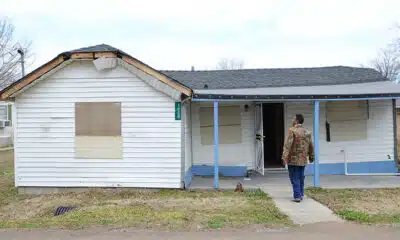Kaiser Health News
Desperate Families Search for Affordable Home Care
Reed Abelson, The New York Times
Mon, 04 Dec 2023 10:00:00 +0000
It’s a good day when Frank Lee, a retired chef, can slip out to the hardware store, fairly confident that his wife, Robin, is in the hands of reliable help. He spends nearly every hour of every day anxiously overseeing her care at their home on the Isle of Palms, a barrier island near Charleston, South Carolina.
Robin Lee, 67, has had dementia for about a decade, but the couple was able to take overseas trips and enjoy their marriage of some 40 years until three years ago, when she grew more agitated, prone to sudden outbursts, and could no longer explain what she needed or wanted. He struggled to care for her largely on his own.
“As Mom’s condition got more difficult to navigate, he was just handling it,” said Jesse Lee, the youngest of the couple’s three adult children. “It was getting harder and harder. Something had to change, or they would both perish.”
Frank Lee’s search for trustworthy home health aides — an experience that millions of American families face — has often been exhausting and infuriating, but he has persisted. He didn’t entirely trust the care his wife would get in an assisted living facility. Last August, when a respite program paid for her brief stay in one so Frank, 69, could take a trip to the mountains, she fell and fractured her sacrum, the bone that connects the spine to the pelvis.
There is precious little assistance from the government for families who need a home health aide, unless they are poor. The people working in these jobs are often woefully underpaid and unprepared to help a frail, older person with dementia bathe and use the bathroom, or to defuse an angry outburst.
Usually, it is family that steps into the breach — grown children who cobble together a fragile chain of visitors to help an ailing father; a middle-aged daughter who returns to her childhood bedroom; a son-in-law working from home who keeps a watchful eye on a confused parent; a wife who can barely manage herself looking after a faltering husband.
Frank Lee finally found two aides on his own, with no help from an agency. Using the proceeds from the sale of his stake in a group of restaurants, including the popular Charleston bistro Slightly North of Broad, he pays them the going rate of about $30 an hour. Between his wife’s care and medical expenses, he estimates he’s spending between $80,000 and $100,000 a year.
“Who the hell can afford this?” he asked. “There’s no relief for families unless they have great wealth or see their wealth sucked away.” He worries that he will run out of money and be forced to sell their home of more than three decades. “Funds aren’t unlimited,” he said.
Credited with emphasizing local ingredients and mentoring young chefs in Charleston, Lee retired in 2016, a few years after his wife’s diagnosis.
In an interview at the time, he said, “My wife has given up her life to help me in my career, and now I need to pay attention to her.”
In 2020, he contacted a half-dozen home care agencies. Some couldn’t fill the position. Others sent aides who were quickly overwhelmed by his wife’s behavior. Doctors told the family they believed she has frontotemporal dementia, which appeared to affect her language and how she behaved.
One woman seemed promising, only to quit after a week or two. “We never saw her again,” Lee said. He tried a friend of the family for a time, but she left when her grandmother developed liver cancer.
“It was the whole year of going through different caregivers,” said son Jesse.
Finally, Frank found two women to help. One of them, Ronnie Smalls, has more than a dozen years of experience and is trained in dementia care. She has developed a rapport with Robin, who seems reassured by a quick touch. “We have a really good bond,” Smalls said. “I know her language, her expression.”
One day at the Lees’ cozy one-story house, decorated with furniture made by Robin, and with a yard overflowing with greenery, Smalls fed her lunch at the kitchen table with her husband and daughter. Robin seemed to enjoy the company, murmuring in response to the conversation.
At other times, she seemed oblivious to the people around her. She can no longer walk on her own. Two people are often needed to help her get up from a chair or go to the bathroom, transitions she often finds upsetting. A day without an aide — out because of illness or a family emergency — frays the tenuous links that hold the couple’s life together.
Lee said his wife barely resembles the woman he married, the one who loved hiking, skiing, and gardening, and who started a neighborhood preschool while raising their three children. A voracious reader, she is now largely silent, staring into space.
The prognosis is bleak, with doctors offering little to hang onto. “What’s the end game look like?” Lee asks, wondering if it would be better if his wife had the right to die rather than slowly disappear before his eyes. “As she disintegrates, I disintegrate,” he said. She recently qualified for hospice care, which will involve weekly visits from a nurse and a certified nursing assistant paid under Medicare.
Charleston is flush with retirees attracted by its low taxes and a warm climate, and it boasts of ways to care for them with large for-profit home health chains and a scattering of small agencies. But many families in Charleston and across the nation can’t find the help they need. And when they do, it’s often spotty and far more expensive than they can afford.
Most Americans want to remain in their own homes, living independently, for as long as possible. They want to avoid nursing homes, which they see as providing poor care, polls have found. And the ranks of older people who need such help will grow. By 2030, 1 in 5 Americans will be at least 65 as millions in the baby boomer generation retire.
In dozens of interviews, families described a desperate and sometimes fruitless search for aides to help loved ones with simple tasks on a predictable schedule at an hourly rate they can afford.
Roughly 8 million people 65 and older had dementia or needed help with two or more activities of basic daily life, like getting out of bed, according to an analysis of a federally funded survey of older Americans by KFF Health News and The New York Times. Only a million received paid help outside of a nursing home, and nearly 3 million had no help at all.
Most families can’t afford what agencies charge — about $27 an hour, according to Genworth, a long-term care insurance company. So, many take their chances on untrained caregivers found through word-of-mouth, Craigslist, or other resources.
A Scarcity of Workers
One of the main obstacles to finding paid help is the chronic shortage of workers. Some 3.7 million people had jobs as aides in home health or personal care in 2022, with half of them earning less than $30,000 year, or $14.51 an hour, according to the Bureau of Labor Statistics. The number of people needed is expected to increase by more than 20% over the next decade. But the working conditions are hard, the pay is usually bad, and the hours are inconsistent.
About 3 million people are working in private homes, according to a 2023 analysis by PHI, a nonprofit that studies and acts as an advocate for the workforce, although official estimates may not count many workers paid off the books or hired outside of an agency by a family. Eighty-five percent of home care workers are women, two-thirds are people of color, and roughly a third are immigrants. The pay is often so low that more than half qualify for public assistance like food stamps or Medicaid.
Dawn Geisler, 53, has made only $10 an hour working as a home health aide in the Charleston area for the past four years, without ever getting a raise. She declined to name the agency that employs her because she doesn’t want to lose her job.
Geisler discovered she liked the work after caring for her mother. Unlike an office job, “every day is just a little bit different,” she said. She now juggles two clients. She might accompany one to the doctor and keep the other one company. “I’m taking care of them like they were my own family,” she said.
The agency provides no guarantee of work and doesn’t always tell her what to expect when she walks through the door, except to say someone has Alzheimer’s or is in a wheelchair. Her supervisors often fail to let her know if her client goes to the hospital, so families know to call her cellphone. She has waited weeks for a new assignment without getting paid a penny. She herself has no health insurance and sometimes relies on food banks to put meals on the table.
“I’m not making enough to pay all the bills I have,” said Geisler, who joined an advocacy group called the Fight for $15, which is pushing to raise the minimum wage in South Carolina and across the country. When her car broke down, she couldn’t afford to get it fixed. Instead, she walked to work or borrowed her fiancé’s bicycle.
Most home health agencies nationwide are for-profit and are often criticized for ignoring the needs of workers in favor of the bottom line.
“The business models are based on cheap labor,” said Robyn Stone, senior vice president of research for LeadingAge, which represents nonprofit agencies. The industry has historically tolerated high turnover but now can’t attract enough workers in a strong, competitive job market. “I think there has been a rude awakening for a lot of these companies,” she said.
Many agencies have also refused to pay overtime or travel costs between jobs, and many have been accused of wage theft in lawsuits filed by home care workers or have been sanctioned by state and federal agencies.
Medicaid, the federal-state program that provides health care for the poor, is supposed to provide home aides but faces shortages of workers at the rates it pays workers. At least 20 states pay less than $20 an hour for a personal care aide, according to a recent state survey by KFF. Aides are often paid less under Medicaid than if they care for someone paying privately.
With low pay and few benefits, many people would rather work the checkout line in a supermarket or at a fast-food chain than take on the emotionally demanding job of caring for an older person, said Ashlee Pittmann, the chief executive of Interim HealthCare of Charleston, a home health agency. She said that she recently raised wages by $2 an hour and had had more success keeping employees, but that she still worried that “we may not be able to compete with some larger companies.”
The Biden administration failed to obtain an additional $400 billion from Congress for home- and community-based services to shift emphasis away from institutional care. President Joe Biden signed an executive order this year to encourage some reforms, and federal officials have proposed requiring home health agencies to spend 80 cents of every government dollar on paying workers under Medicaid. But so far, little has changed.
Falling Through the ‘Doughnut Hole‘
Long-term care coverage for most Americans is a yawning gap in government programs. And the chasm is widening as more Americans age into their 70s, 80s, and 90s.
The government’s main program for people 65 and older is Medicare, but it pays for a home aide only when a medical condition, like recovery from a stroke, has made a person eligible for a nurse or therapist to come to the home. And the aide is usually short-term. Medicare doesn’t cover long-term care.
Medicaid, which does pay for long-term care at home, is limited to serving the poor or those who can demonstrate they have hardly any assets. But, again, the worker shortage is so pervasive that waiting lists for aides are years long, leaving many people without any option except a nursing home.
So millions of Americans keep trying to hang in and stay home as long as they can. They’re not poor enough to qualify for Medicaid, but they can’t afford to hire someone privately.
Many fall through what April Abel, a former home health nurse from Roper St. Francis Healthcare in Charleston, described as “the doughnut hole.”
“I feel so bad for them because they don’t have the support system they need,” she said.
She tried fruitlessly for months to find help for Joanne Ganaway, 79 and in poor health, from charities or state programs while she visited her at home. Ganaway had trouble seeing because of a tear in her retina and was often confused about her medications, but the small pension she had earned after working nearly 20 years as a state employee made her ineligible for Medicaid-sponsored home care.
So Ganaway, who rarely leaves her house, relies on friends or family to get to the doctor or the store. She spends most of her day in a chair in the living room. “It has been difficult for me, to be honest,” she said.
Turning to Respite Services
With no hope of steady help, there is little left to offer overstretched wives, husbands, sons, and daughters other than a brief respite. The Biden administration has embraced the idea of respite services under Medicare, including a pilot program for the families of dementia patients that will begin in 2024.
One nonprofit, Respite Care Charleston, provides weekday drop-off sessions for people with dementia for almost four hours a day.
Lee’s wife went for a couple of years, and he still makes use of the center’s support groups, where caregivers talk about the strain of watching over a loved one’s decline.
On any given morning, nearly a dozen people with dementia gather around a table. Two staff members and a few volunteers work with the group as they play word games, banter, bat balls around, or send a small plastic jumping frog across the table.
Their visits cost $50 a session, including lunch, and the organization’s brief hours keep it under the minimum state requirements for licensing.
“We’re not going to turn someone away,” Sara Perry, the group’s executive director, said. “We have some folks who pay nothing.”
The service is a godsend, families say. Parkinson’s disease and a stroke have left Dottie Fulmer’s boyfriend, Martyn Howse, mentally and physically incapacitated, but he enjoys the sessions.
“Respite Care Charleston has been a real key to his keeping going,” she said, “to both of us, quite frankly, continuing to survive.”
——————————
By: Reed Abelson, The New York Times
Title: Desperate Families Search for Affordable Home Care
Sourced From: kffhealthnews.org/news/article/dying-broke-desperate-families-search-for-affordable-home-care/
Published Date: Mon, 04 Dec 2023 10:00:00 +0000
Kaiser Health News
Dual Threats From Trump and GOP Imperil Nursing Homes and Their Foreign-Born Workers
In a top-rated nursing home in Alexandria, Virginia, the Rev. Donald Goodness is cared for by nurses and aides from various parts of Africa. One of them, Jackline Conteh, a naturalized citizen and nurse assistant from Sierra Leone, bathes and helps dress him most days and vigilantly intercepts any meal headed his way that contains gluten, as Goodness has celiac disease.
“We are full of people who come from other countries,” Goodness, 92, said about Goodwin House Alexandria’s staff. Without them, the retired Episcopal priest said, “I would be, and my building would be, desolate.”
The long-term health care industry is facing a double whammy from President Donald Trump’s crackdown on immigrants and the GOP’s proposals to reduce Medicaid spending. The industry is highly dependent on foreign workers: More than 800,000 immigrants and naturalized citizens comprise 28% of direct care employees at home care agencies, nursing homes, assisted living facilities, and other long-term care companies.
But in January, the Trump administration rescinded former President Joe Biden’s 2021 policy that protected health care facilities from Immigration and Customs Enforcement raids. The administration’s broad immigration crackdown threatens to drastically reduce the number of current and future workers for the industry. “People may be here on a green card, and they are afraid ICE is going to show up,” said Katie Smith Sloan, president of LeadingAge, an association of nonprofits that care for older adults.
Existing staffing shortages and quality-of-care problems would be compounded by other policies pushed by Trump and the Republican-led Congress, according to nursing home officials, resident advocates, and academic experts. Federal spending cuts under negotiation may strip nursing homes of some of their largest revenue sources by limiting ways states leverage Medicaid money and making it harder for new nursing home residents to retroactively qualify for Medicaid. Care for 6 in 10 residents is paid for by Medicaid, the state-federal health program for poor or disabled Americans.
“We are facing the collision of two policies here that could further erode staffing in nursing homes and present health outcome challenges,” said Eric Roberts, an associate professor of internal medicine at the University of Pennsylvania.
The industry hasn’t recovered from covid-19, which killed more than 200,000 long-term care facility residents and workers and led to massive staff attrition and turnover. Nursing homes have struggled to replace licensed nurses, who can find better-paying jobs at hospitals and doctors’ offices, as well as nursing assistants, who can earn more working at big-box stores or fast-food joints. Quality issues that preceded the pandemic have expanded: The percentage of nursing homes that federal health inspectors cited for putting residents in jeopardy of immediate harm or death has risen alarmingly from 17% in 2015 to 28% in 2024.
In addition to seeking to reduce Medicaid spending, congressional Republicans have proposed shelving the biggest nursing home reform in decades: a Biden-era rule mandating minimum staffing levels that would require most of the nation’s nearly 15,000 nursing homes to hire more workers.
The long-term care industry expects demand for direct care workers to burgeon with an influx of aging baby boomers needing professional care. The Census Bureau has projected the number of people 65 and older would grow from 63 million this year to 82 million in 2050.
In an email, Vianca Rodriguez Feliciano, a spokesperson for the Department of Health and Human Services, said the agency “is committed to supporting a strong, stable long-term care workforce” and “continues to work with states and providers to ensure quality care for older adults and individuals with disabilities.” In a separate email, Tricia McLaughlin, a Department of Homeland Security spokesperson, said foreigners wanting to work as caregivers “need to do that by coming here the legal way” but did not address the effect on the long-term care workforce of deportations of classes of authorized immigrants.
Goodwin Living, a faith-based nonprofit, runs three retirement communities in northern Virginia for people who live independently, need a little assistance each day, have memory issues, or require the availability of around-the-clock nurses. It also operates a retirement community in Washington, D.C. Medicare rates Goodwin House Alexandria as one of the best-staffed nursing homes in the country. Forty percent of the organization’s 1,450 employees are foreign-born and are either seeking citizenship or are already naturalized, according to Lindsay Hutter, a Goodwin spokesperson.
“As an employer, we see they stay on with us, they have longer tenure, they are more committed to the organization,” said Rob Liebreich, Goodwin’s president and CEO.
Jackline Conteh spent much of her youth shuttling between Sierra Leone, Liberia, and Ghana to avoid wars and tribal conflicts. Her mother was killed by a stray bullet in her home country of Liberia, Conteh said. “She was sitting outside,” Conteh, 56, recalled in an interview.
Conteh was working as a nurse in a hospital in Sierra Leone in 2009 when she learned of a lottery for visas to come to the United States. She won, though she couldn’t afford to bring her husband and two children along at the time. After she got a nursing assistant certification, Goodwin hired her in 2012.
Conteh said taking care of elders is embedded in the culture of African families. When she was 9, she helped feed and dress her grandmother, a job that rotated among her and her sisters. She washed her father when he was dying of prostate cancer. Her husband joined her in the United States in 2017; she cares for him because he has heart failure.
“Nearly every one of us from Africa, we know how to care for older adults,” she said.
Her daughter is now in the United States, while her son is still in Africa. Conteh said she sends money to him, her mother-in-law, and one of her sisters.
In the nursing home where Goodness and 89 other residents live, Conteh helps with daily tasks like dressing and eating, checks residents’ skin for signs of swelling or sores, and tries to help them avoid falling or getting disoriented. Of 102 employees in the building, broken up into eight residential wings called “small houses” and a wing for memory care, at least 72 were born abroad, Hutter said.
Donald Goodness grew up in Rochester, New York, and spent 25 years as rector of The Church of the Ascension in New York City, retiring in 1997. He and his late wife moved to Alexandria to be closer to their daughter, and in 2011 they moved into independent living at the Goodwin House. In 2023 he moved into one of the skilled nursing small houses, where Conteh started caring for him.
“I have a bad leg and I can’t stand on it very much, or I’d fall over,” he said. “She’s in there at 7:30 in the morning, and she helps me bathe.” Goodness said Conteh is exacting about cleanliness and will tell the housekeepers if his room is not kept properly.
Conteh said Goodness was withdrawn when he first arrived. “He don’t want to come out, he want to eat in his room,” she said. “He don’t want to be with the other people in the dining room, so I start making friends with him.”
She showed him a photo of Sierra Leone on her phone and told him of the weather there. He told her about his work at the church and how his wife did laundry for the choir. The breakthrough, she said, came one day when he agreed to lunch with her in the dining room. Long out of his shell, Goodness now sits on the community’s resident council and enjoys distributing the mail to other residents on his floor.
“The people that work in my building become so important to us,” Goodness said.
While Trump’s 2024 election campaign focused on foreigners here without authorization, his administration has broadened to target those legally here, including refugees who fled countries beset by wars or natural disasters. This month, the Department of Homeland Security revoked the work permits for migrants and refugees from Cuba, Haiti, Nicaragua, and Venezuela who arrived under a Biden-era program.
“I’ve just spent my morning firing good, honest people because the federal government told us that we had to,” Rachel Blumberg, president of the Toby & Leon Cooperman Sinai Residences of Boca Raton, a Florida retirement community, said in a video posted on LinkedIn. “I am so sick of people saying that we are deporting people because they are criminals. Let me tell you, they are not all criminals.”
At Goodwin House, Conteh is fearful for her fellow immigrants. Foreign workers at Goodwin rarely talk about their backgrounds. “They’re scared,” she said. “Nobody trusts anybody.” Her neighbors in her apartment complex fled the U.S. in December and returned to Sierra Leone after Trump won the election, leaving their children with relatives.
“If all these people leave the United States, they go back to Africa or to their various countries, what will become of our residents?” Conteh asked. “What will become of our old people that we’re taking care of?”
KFF Health News is a national newsroom that produces in-depth journalism about health issues and is one of the core operating programs at KFF—an independent source of health policy research, polling, and journalism. Learn more about KFF.
Subscribe to KFF Health News’ free Morning Briefing.
This article first appeared on KFF Health News and is republished here under a Creative Commons license.
The post Dual Threats From Trump and GOP Imperil Nursing Homes and Their Foreign-Born Workers appeared first on kffhealthnews.org
Note: The following A.I. based commentary is not part of the original article, reproduced above, but is offered in the hopes that it will promote greater media literacy and critical thinking, by making any potential bias more visible to the reader –Staff Editor.
Political Bias Rating: Center-Left
This content primarily highlights concerns about the impact of restrictive immigration policies and Medicaid spending cuts proposed by the Trump administration and Republican lawmakers on the long-term care industry. It emphasizes the importance of immigrant workers in healthcare, the challenges that staffing shortages pose to patient care, and the potential negative effects of GOP policy proposals. The tone is critical of these policies while sympathetic toward immigrant workers and advocates for maintaining or increasing government support for healthcare funding. The framing aligns with a center-left perspective, focusing on social welfare, immigrant rights, and concern about the consequences of conservative economic and immigration policies without descending into partisan rhetoric.
Kaiser Health News
California’s Much-Touted IVF Law May Be Delayed Until 2026, Leaving Many in the Lurch
California lawmakers are poised to delay the state’s much-ballyhooed new law mandating in vitro fertilization insurance coverage for millions, set to take effect July 1. Gov. Gavin Newsom has asked lawmakers to push the implementation date to January 2026, leaving patients, insurers, and employers in limbo.
The law, SB 729, requires state-regulated health plans offered by large employers to cover infertility diagnosis and treatment, including IVF. Nine million people will qualify for coverage under the law. Advocates have praised the law as “a major win for Californians,” especially in making same-sex couples and aspiring single parents eligible, though cost concerns limited the mandate’s breadth.
People who had been planning fertility care based on the original timeline are now “left in a holding pattern facing more uncertainty, financial strain, and emotional distress,” Alise Powell, a director at Resolve: The National Infertility Association, said in a statement.
During IVF, a patient’s eggs are retrieved, combined with sperm in a lab, and then transferred to a person’s uterus. A single cycle can total around $25,000, out of reach for many. The California law requires insurers to cover up to three egg retrievals and an unlimited number of embryo transfers.
Not everyone’s coverage would be affected by the delay. Even if the law took effect July 1, it wouldn’t require IVF coverage to start until the month an employer’s contract renews with its insurer. Rachel Arrezola, a spokesperson for the California Department of Managed Health Care, said most of the employers subject to the law renew their contracts in January, so their employees would not be affected by a delay.
She declined to provide data on the percentage of eligible contracts that renew in July or later, which would mean those enrollees wouldn’t get IVF coverage until at least a full year from now, in July 2026 or later.
The proposed new implementation date comes amid heightened national attention on fertility coverage. California is now one of 15 states with an IVF mandate, and in February, President Donald Trump signed an executive order seeking policy recommendations to expand IVF access.
It’s the second time Newsom has asked lawmakers to delay the law. When the Democratic governor signed the bill in September, he asked the legislature to consider delaying implementation by six months. The reason, Newsom said then, was to allow time to reconcile differences between the bill and a broader effort by state regulators to include IVF and other fertility services as an essential health benefit, which would require the marketplace and other individual and small-group plans to provide the coverage.
Newsom spokesperson Elana Ross said the state needs more time to provide guidance to insurers on specific services not addressed in the law to ensure adequate and uniform coverage. Arrezola said embryo storage and donor eggs and sperm were examples of services requiring more guidance.
State Sen. Caroline Menjivar, a Democrat who authored the original IVF mandate, acknowledged a delay could frustrate people yearning to expand their families, but requested patience “a little longer so we can roll this out right.”
Sean Tipton, a lobbyist for the American Society for Reproductive Medicine, contended that the few remaining questions on the mandate did not warrant a long delay.
Lawmakers appear poised to advance the delay to a vote by both houses of the legislature, likely before the end of June. If a delay is approved and signed by the governor, the law would immediately be paused. If this does not happen before July 1, Arrezola said, the Department of Managed Health Care would enforce the mandate as it exists. All plans were required to submit compliance filings to the agency by March. Arrezola was unable to explain what would happen to IVF patients whose coverage had already begun if the delay passes after July 1.
The California Association of Health Plans, which opposed the mandate, declined to comment on where implementation efforts stand, although the group agrees that insurers need more guidance, spokesperson Mary Ellen Grant said.
Kaiser Permanente, the state’s largest insurer, has already sent employers information they can provide to their employees about the new benefit, company spokesperson Kathleen Chambers said. She added that eligible members whose plans renew on or after July 1 would have IVF coverage if implementation of the law is not delayed.
Employers and some fertility care providers appear to be grappling over the uncertainty of the law’s start date. Amy Donovan, a lawyer at insurance brokerage and consulting firm Keenan & Associates, said the firm has fielded many questions from employers about the possibility of delay. Reproductive Science Center and Shady Grove Fertility, major clinics serving different areas of California, posted on their websites that the IVF mandate had been delayed until January 2026, which is not yet the case. They did not respond to requests for comment.
Some infertility patients confused over whether and when they will be covered have run out of patience. Ana Rios and her wife, who live in the Central Valley, had been trying to have a baby for six years, dipping into savings for each failed treatment. Although she was “freaking thrilled” to learn about the new law last fall, Rios could not get clarity from her employer or health plan on whether she was eligible for the coverage and when it would go into effect, she said. The couple decided to go to Mexico to pursue cheaper treatment options.
“You think you finally have a helping hand,” Rios said of learning about the law and then, later, the requested delay. “You reach out, and they take it back.”
This article was produced by KFF Health News, which publishes California Healthline, an editorially independent service of the California Health Care Foundation.
KFF Health News is a national newsroom that produces in-depth journalism about health issues and is one of the core operating programs at KFF—an independent source of health policy research, polling, and journalism. Learn more about KFF.
USE OUR CONTENT
This story can be republished for free (details).
KFF Health News is a national newsroom that produces in-depth journalism about health issues and is one of the core operating programs at KFF—an independent source of health policy research, polling, and journalism. Learn more about KFF.
Subscribe to KFF Health News’ free Morning Briefing.
This article first appeared on KFF Health News and is republished here under a Creative Commons license.
The post California’s Much-Touted IVF Law May Be Delayed Until 2026, Leaving Many in the Lurch appeared first on kffhealthnews.org
Note: The following A.I. based commentary is not part of the original article, reproduced above, but is offered in the hopes that it will promote greater media literacy and critical thinking, by making any potential bias more visible to the reader –Staff Editor.
Political Bias Rating: Center-Left
This content is presented in a factual, balanced manner typical of center-left public policy reporting. It focuses on a progressive healthcare issue (mandated IVF insurance coverage) favorably highlighting benefits for diverse family structures and individuals, including same-sex couples and single parents, which often aligns with center-left values. At the same time, it includes perspectives from government officials, industry representatives, opponents, and patients, offering a nuanced view without overt ideological framing or partisan rhetoric. The emphasis on healthcare access, social equity, and patient impact situates the coverage within a center-left orientation.
Kaiser Health News
Push To Move OB-GYN Exam Out of Texas Is Piece of AGs’ Broader Reproductive Rights Campaign
Democratic state attorneys general led by those from California, New York, and Massachusetts are pressuring medical professional groups to defend reproductive rights, including medication abortion, emergency abortions, and travel between states for health care in response to recent increases in the number of abortion bans.
The American Medical Association adopted a formal position June 9 recommending that medical certification exams be moved out of states with restrictive abortion policies or made virtual, after 20 attorneys general petitioned to protect physicians who fear legal repercussions because of their work. The petition focused on the American Board of Obstetrics and Gynecology’s certification exams in Dallas, and the subsequent AMA recommendation was hailed as a win for Democrats trying to regain ground after the fall of Roe v. Wade.
“It seems incremental, but there are so many things that go into expanding and maintaining access to care,” said Arneta Rogers, executive director of the Center on Reproductive Rights and Justice at the University of California-Berkeley’s law school. “We see AGs banding together, governors banding together, as advocates work on the ground. That feels somewhat more hopeful — that people are thinking about a coordinated strategy.”
Since the Supreme Court eliminated the constitutional right to an abortion in 2022, 16 states, including Texas, have implemented laws banning abortion almost entirely, and many of them impose criminal penalties on providers as well as options to sue doctors. More than 25 states restrict access to gender-affirming care for trans people, and six of them make it a felony to provide such care to youth.
That’s raised concern among some physicians who fear being charged if they go to those states, even if their home state offers protection to provide reproductive and gender-affirming health care.
Pointing to the recent fining and indictment of a physician in New York who allegedly provided abortion pills to a woman in Texas and a teen in Louisiana, a coalition of physicians wrote in a letter to the American Board of Obstetrics and Gynecology that “the limits of shield laws are tenuous” and that “Texas laws can affect physicians practicing outside of the state as well.”
The campaign was launched by several Democratic attorneys general, including Rob Bonta of California, Andrea Joy Campbell of Massachusetts, and Letitia James of New York, who each have established a reproductive rights unit as a bulwark for their state following the Dobbs decision.
“Reproductive health care and gender-affirming care providers should not have to risk their safety or freedom just to advance in their medical careers,” James said in a statement. “Forcing providers to travel to states that have declared war on reproductive freedom and LGBTQ+ rights is as unnecessary as it is dangerous.”
In their petition, the attorneys general included a letter from Joseph Ottolenghi, medical director at Choices Women’s Medical Center in New York City, who was denied his request to take the test remotely or outside of Texas. To be certified by the American Board of Obstetrics and Gynecology, physicians need to take the in-person exam at its testing facility in Dallas. The board completed construction of its new testing facility last year.
“As a New York practitioner, I have made every effort not to violate any other state’s laws, but the outer contours of these draconian laws have not been tested or clarified by the courts,” Ottolenghi wrote.
Rachel Rebouché, the dean of Temple University’s law school and a reproductive law scholar, said “putting the heft” of the attorneys general behind this effort helps build awareness and a “public reckoning” on behalf of providers. Separately, some doctors have urged medical conferences to boycott states with abortion bans.
Anti-abortion groups, however, see the campaign as forcing providers to conform to abortion-rights views. Donna Harrison, an OB-GYN and the director of research at the American Association of Pro-Life Obstetricians and Gynecologists, described the petition as an “attack not only on pro-life states but also on life-affirming medical professionals.”
Harrison said the “OB-GYN community consists of physicians with values that are as diverse as our nation’s state abortion laws,” and that this diversity “fosters a medical environment of debate and rigorous thought leading to advancements that ultimately serve our patients.”
The AMA’s new policy urges specialty medical boards to host exams in states without restrictive abortion laws, offer the tests remotely, or provide exemptions for physicians. However, the decision to implement any changes to the administration of these exams is up to those boards. There is no deadline for a decision to be made.
The OB-GYN board did not respond to requests for comment, but after the public petition from the attorneys general criticizing it for refusing exam accommodations, the board said that in-person exams conducted at its national center in Dallas “provide the most equitable, fair, secure, and standardized assessment.”
The OB-GYN board emphasized that Texas’ laws apply to doctors licensed in Texas and to medical care within Texas, specifically. And it noted that its exam dates are kept under wraps, and that there have been “no incidents of harm to candidates or examiners across thousands of in-person examinations.”
Democratic state prosecutors, however, warned in their petition that the “web of confusing and punitive state-based restrictions creates a legal minefield for medical providers.” Texas is among the states that have banned doctors from providing gender-affirming care to transgender youth, and it has reportedly made efforts to get records from medical facilities and professionals in other states who may have provided that type of care to Texans.
The Texas attorney general’s office did not respond to requests for comment.
States such as California and New York have laws to block doctors from being extradited under other states’ laws and to prevent sharing evidence against them. But instances that require leveraging these laws could still mean lengthy legal proceedings.
“We live in a moment where we’ve seen actions by executive bodies that don’t necessarily square with what we thought the rules provided,” Rebouché said.
This article was produced by KFF Health News, which publishes California Healthline, an editorially independent service of the California Health Care Foundation.
KFF Health News is a national newsroom that produces in-depth journalism about health issues and is one of the core operating programs at KFF—an independent source of health policy research, polling, and journalism. Learn more about KFF.
USE OUR CONTENT
This story can be republished for free (details).
KFF Health News is a national newsroom that produces in-depth journalism about health issues and is one of the core operating programs at KFF—an independent source of health policy research, polling, and journalism. Learn more about KFF.
Subscribe to KFF Health News’ free Morning Briefing.
This article first appeared on KFF Health News and is republished here under a Creative Commons license.
The post Push To Move OB-GYN Exam Out of Texas Is Piece of AGs’ Broader Reproductive Rights Campaign appeared first on kffhealthnews.org
Note: The following A.I. based commentary is not part of the original article, reproduced above, but is offered in the hopes that it will promote greater media literacy and critical thinking, by making any potential bias more visible to the reader –Staff Editor.
Political Bias Rating: Center-Left
The article presents a viewpoint largely aligned with progressive and Democratic positions on reproductive rights and gender-affirming care. It highlights efforts led by Democratic attorneys general and the American Medical Association to protect abortion access and transgender healthcare amid restrictive state laws, portraying these actions positively. While it includes perspectives from anti-abortion advocates, their views are presented briefly and framed as opposition to the broader pro-choice initiatives. The overall tone and framing emphasize support for reproductive freedom and healthcare protections, reflecting a center-left leaning stance typical of mainstream health policy reporting sympathetic to Democratic policy goals.
-
News from the South - Tennessee News Feed7 days ago
Thieves take thousands of dollars in equipment from Union County Soccer League
-
Mississippi Today4 days ago
Defendant in auditor’s ‘second largest’ embezzlement case in history goes free
-
News from the South - Texas News Feed6 days ago
Robert Nichols to retire from Texas Senate
-
News from the South - Louisiana News Feed6 days ago
3 lawsuits filed against CVS, Louisiana AG announces
-
News from the South - Florida News Feed6 days ago
DeSantis signs bill into law that ensures public access to Florida beaches | Florida
-
News from the South - Missouri News Feed6 days ago
Residents provide feedback in Kearney Street Corridor redevelopment meeting
-
The Conversation6 days ago
The Vera C. Rubin Observatory will help astronomers investigate dark matter, continuing the legacy of its pioneering namesake
-
News from the South - Alabama News Feed6 days ago
News 5 NOW at 12:30pm | June 24, 2025















































